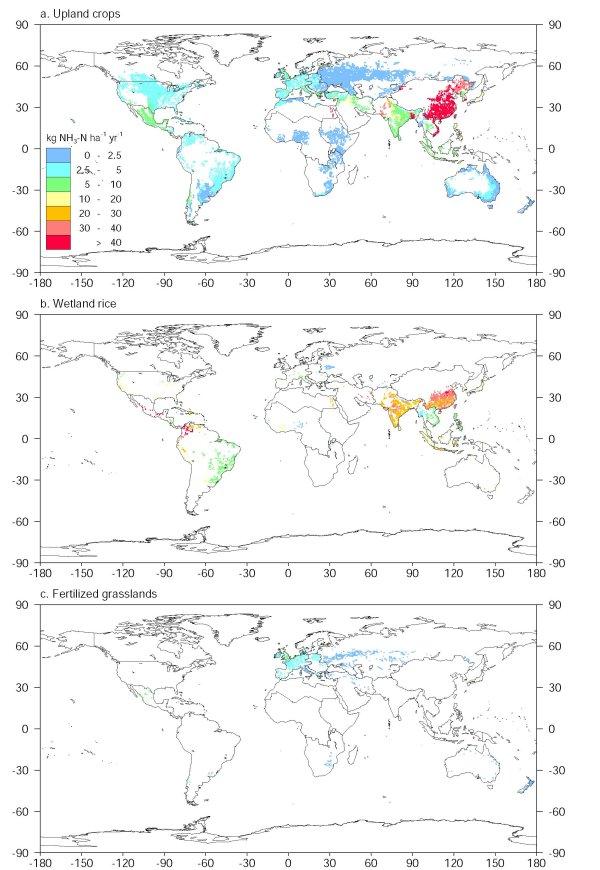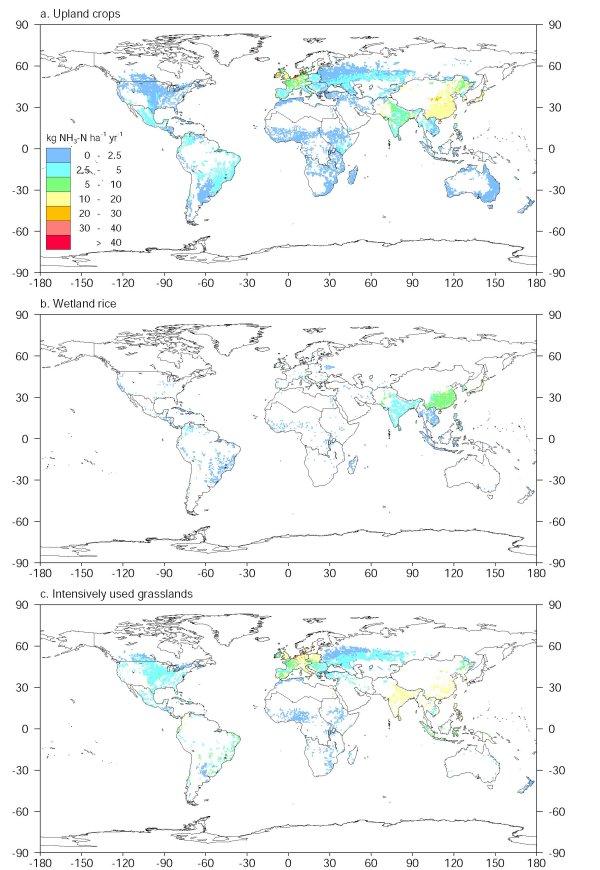Estimation of global NH3 volatilization loss from synthetic fertilizers and animal manure applied to arable lands and grasslands
One of the main causes of the low efficiency in nitrogen (N) use by crops is the volatilization of ammonia (NH3) from fertilizers. Information taken from 1667 NH3 volatilization measurements documented in 148 research papers was summarized to assess the influence on NH3 volatilization of crop type, fertilizer type, and rate and mode of application and temperature, as well as soil organic carbon, texture, pH, CEC, measurement technique, and measurement location.
The calculated median NH3 loss from global application of synthetic N fertilizers (78 million tons N per year) and animal manure (33 million tons N per year) amount to 14% (10–19%) and 23% (19–29%), respectively. In developing countries, because of high temperatures and the widespread use of urea, ammonium sulfate, and ammonium bicarbonate, estimated NH3 volatilization loss from synthetic fertilizers amounts to 18%, and in industrialized countries it amounts to 7%. The estimated NH3 loss from animal manure is 21% in industrialized and 26% in developing countries.
Recently a new inventory of ammonia (NH3) emissions from agriculture was made. By using more measurement data and a model approach based on regulating factors, this new inventory of NH3 volatilization from agricultural fields amended with synthetic fertilizers and animal manure is hoped to be an improvement of previous inventories based on emission factors included in the EDGAR/GEIA inventory.
Ammonia
Ammonia is an important atmospheric pollutant with a wide variety of impacts. In the atmosphere NH3 neutralizes a great portion of the acids produced by oxides of sulfur and nitrogen. A great part of atmospheric aerosols, acting as cloud condensation nuclei, consist of sulfate neutralized to various extents by NH3. Essentially all emitted NH3 is returned to the surface by deposition, which is known to be one of the causes of soil acidification since the early 1980s. The role of NH3 as a fertilizer was already known more than a century ago. In the last few years there has been growing concern about the eutrophication of natural ecosystems and loss of biodiversity due to N deposition. Agricultural sources, in particular the use of synthetic fertilizers and animal manure, make up about 50% of the global emission of NH3.
Assessment of NH3 volatilization
Information taken from 1667 NH3 volatilization measurements documented in 148 research papers was summarized to assess the influence on NH3 volatilization of crop type, fertilizer type, rate and mode of application and temperature, as well as soil organic carbon, texture, pH, CEC, measurement technique and measurement location.
The data set was summarized in three ways:
- by calculating means for each of the factors mentioned, in which findings from each research paper were weighted equally;
- by calculating weighted median values corrected for unbalanced features of the collected data;
- by developing a summary model using linear regression based on weighted median values for NH3 volatilization and by calculating global NH3 volatilization losses from fertilizer application using 0.5o resolution data on land use and soils.
Results
The results indicate that the global NH3 loss from synthetic fertilizers is 11 million tonne N yr-1, which is 14% of the applied fertilizer N. The NH3 loss from synthetic N fertilizers used in wetland rice cultivation is 20% of the 11.8 million tonne N used annually. In upland systems the NH3 loss is 14% of the 61.7 million tonne of synthetic fertilizer N used per year. In grasslands the annual global use of synthetic fertilizer N is only 4.3 million tonne, mostly in industrialized countries, with estimated NH3 loss rates of 6%. High NH3 losses from synthetic N fertilizers in developing countries are due to high temperatures and the widespread use of urea (60% of N fertilizer use) and ammonium bicarbonate (19%). Both of these are prone to high NH3 volatilization losses. In industrialized countries the use of urea makes up only 16% of N fertilizer use, and ammonium bicarbonate is not used at all.
The global annual NH3 loss from the use of 12.4 million tonne N in animal manure in grasslands amounts to 23% of the N application. In upland crops a global 26% of the 17.4 million tonne N from annual application of animal manure is lost as NH3. In wetland rice systems the estimated annual use of N from animal manure is 3.3 million tonne and the global NH3 loss is 17%. In wetland rice we assumed that animal manure is incorporated, giving lower volatilization rates than for broadcasting in upland soils under grass or crops.


The following data can be downloaded
- File nh3-data (ZIP, 193KB) The data set of measurement data, including the references used.
ASCII files containing global NH3 emissions as a 360 (rows) by 720 (columns) matrix. The first cell is -179.5N + 89.5 N. Coordinates represent the bottom-left corner of each grid cell.
The following files can be downloaded:
This zipfile contains the following ASCII files:
| File | Unit | From application | Crop type |
|---|---|---|---|
| NH3-AW-C.ASC | kg N/ha/yr | Animal waste | Upland crops |
| NH3-AW-G.ASC | kg N/ha/yr | Animal waste | Grasslands |
| NH3-AW-R.ASC | kg N/ha/yr | Animal waste | Wetland rice |
| NH3-FE-C.ASC | kg N/ha/yr | Sythetic N fertilizers | Upland crops |
| NH3-FE-G.ASC | kg N/ha/yr | Sythetic N fertilizers | Grasslands |
| NH3-FE-R.ASC | kg N/ha/yr | Sythetic N fertilizers | Wetland rice |
| NH3TAW-A.ASC | ton N/grid cell/yr | Animal waste | none |
| NH3TFE-A.ASC | ton N/grid cell/yr | Sythetic N fertilizers | none |
References
- FAO/IFA (2001) Global estimates of gaseous emissions of NH3, NO and N2O from agricultural land. Food and Agriculture Organization of the United Nations, International Fertilizer Industry Association, Rome. Can be requested from IFA
- A.F. Bouwman, L.J.M. Boumans and N.H. Batjes (2001) Estimation of global NH3 volatilization loss from synthetic fertilizers and animal manure applied to arable lands and grasslands. Global Biogeochemical Cycles (in press).
Authors
Specifications
- Publication title
- Estimation of global NH3 volatilization loss from synthetic fertilizers and animal manure applied to arable lands and grasslands
- Publication date
- 5 June 2002
- Publication type
- Publication
- Magazine
- Global Biogeochem Cycles 2002; 16
- Product number
- 90869